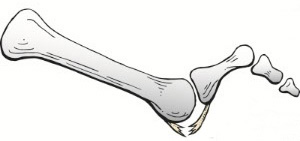
Dislocated metatarsal phalangeal joint
(Plantar plate rupture)
The operation can be performed comfortably under a local anaesthetic block, which is achieved by either a series of injections around the ankle, or an injection behind your knee. You can be fully awake during the operation and will be able to feel touch, pressure and vibration, but you will not feel any pain.
The operation takes about 45–60 minutes although you will be in the day surgery unit for some time before the surgery and afterwards, to allow you an opportunity to rest post-operatively. You must have a competent adult at home for the first day and night after surgery. This allows us to be sure you will be safe for the first night.
Aims of Surgery
- Reduce the pressure and pain under the head of the bone/ball of the foot and in the joint.
- Realign the joint correctly to avoid long-term arthritis and further deformity.
Advantages of this Operation
- The shortening and reduction of prominence are predictable.
- The underlying cause of the pain and deformity is addressed.
Specific Risks of this Operation
- Transfer of corn to an adjacent joint (30%).
- Feeling of joint stiffness (approximately 2.4%).
- Toe may not touch the ground (floating toe).
- Recurrence of the deformity.
- Scarring.
- Non-union of bone (bone does not knit together).
- Fixation problems with screws/pins.
- Pain at the surgical site.
- Need for further surgery.
- Deep vein thrombosis or pulmonary embolism.
Operation Time
Usually about 45–60 minutes.
Incision Placement/Stitches
On the top of the foot over the bone to be corrected, with absorbable stitches where possible. Occasionally, if the ligament cannot be repaired dorsally, a second incision under the joint may be required to repair the ligament.
Procedure
- A controlled fracture is performed on the metatarsal, and the bone is lifted up.
- The ligament is identified and repaired through the same incision or occasionally from under the foot. Sometimes, a skin lesion under the ball of the foot is removed at the same time.
Fixation
A wire or screw is used to hold the bone cut together. These are typically not noticeable and do not usually need to be removed (<20%).
Will I Have Plaster?
No. You will be provided with a special shoe.
Is This a Day Procedure?
Yes, you will go home the same day.
Estimated Time Off Work
- Non-manual work: approximately 4–6 weeks.
- Manual work: approximately 6–8 weeks.
Indications for the Procedure
- Pain, callous, or corn formation beneath the ball of the foot.
- Difficulty with shoe fit despite wearing sensible footwear.
Alternative Treatments
- Manage symptoms by altering activity levels, using painkillers and anti-inflammatories, extra depth/width shoes, rocker sole (stiff curved sole), using an insole or orthotic foot support, and joint injection therapy.
- Regular podiatry care to reduce painful lesions.
- Steroid injections for painful joints.
Post-Operative Care
First 2–4 days after surgery
-
This is the time you are likely to have the most pain, but you will be given painkillers to help. You must rest completely for 2–4 days.
-
You will be able to stand and take weight on your non-operated foot after the operation, but you must rest, with your feet up, as much as possible.
-
You should restrict your walking to going to the bathroom. When getting about, use your shoe in the way you will have been shown.
-
You can get about a little more after 2 days.
1 week after surgery
-
You will need to attend an appointment for your foot to be checked and redressed.
-
You may start to do a little more within pain limits. Pain and swelling means you are doing too much.
2 weeks after surgery
-
Sutures will be removed if necessary.
-
You may be asked to move your toe through a range of motion to maintain mobility.
Between 3–4 weeks after surgery
-
An x-ray will be taken to check bone healing.
-
Once directed by your consultant, you will be able to start wearing a good lace-up shoe/trainer.
-
You will not need a bandage any longer and can get the foot wet.
Between 4–8 weeks after surgery
-
The foot starts to return to normal and you can return to normal shoes (4–8 weeks) (89%).
-
The foot will still be quite swollen especially at the end of the day.
-
You may return to work but may need longer if you have an active job.
-
You may return to driving if you can perform an emergency stop. You must check with your insurance company and Mr. Cichero before driving again.
-
Whilst normal activity will be resumed, sport should be avoided.
Between 8–12 weeks after surgery
-
The foot should continue to improve and begin to feel normal again.
-
There will be less swelling.
-
Sport can be considered after 3 months depending on your recovery.
6 months after surgery
-
You will have a final review between 3–6 months following surgery.
-
The swelling should now be slight and you should be getting the full benefit of the surgery.
12 months after surgery
The foot has stopped improving with all healing complete.
Please note, if a complication arises, recovery may be delayed.
Start your healthcare journey
For more information, questions or queries, please email us or call 01872 392087.

